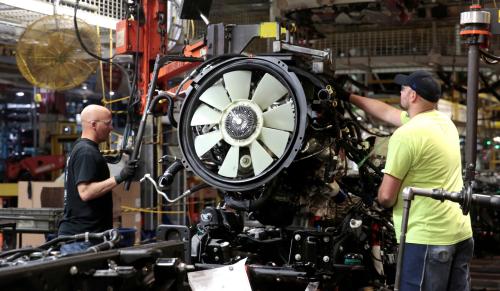There is no shortage of factors that may still decide the 2020 presidential election, including the president’s health, the successful counting of mail-in ballots, and the relative motivation and turnout numbers for Donald Trump and Joe Biden voters in battleground states such as Wisconsin, Pennsylvania, and Michigan. But it also may hinge on the very same factor it did in the 2016 election: the attitudes of working-class whites in and around once-mighty, currently hollowed-out manufacturing communities in those same battleground states. In 2016, in key Midwest battleground states, these voters joined conservatives in the rural hinterlands to put Donald Trump in the White House—turning U.S. politics inside out.
After the 2016 election, I analyzed the interplay between economic anxiety, cultural angst, and voting behavior. For many residents of regions in economic transition—namely, Wisconsin, Pennsylvania, and Michigan—anxieties about an economic future for themselves and their children interacted with a perceived loss of identity, status, and control in a more diverse society with shifting cultural norms. These dynamics mixed a toxic brew of resentments, alongside a craving for a return to a more recognizable time. This nostalgia and anger became fertile ground for Trump’s appeal to bring back the jobs and industries of the past (Steel! Coal! Manufacturing!), and to blame “others” like immigrants for the loss of status and control.
Last year, Brookings Metro assessed the conditions and prospects of a set of 141 small and medium-sized “legacy” communities—older industrial metro areas that share a manufacturing-based heritage. Some of these communities (most numerous across the Midwest), have managed to shed their industrial skins and find new economic diversification and purchase in a changed economy. But many continue to struggle.
In my home state of Michigan, there are many historically Democratic, blue-collar strongholds among these legacy communities that flipped or almost flipped from supporting Barack Obama in 2012 to Trump in 2016. These include once-thriving midsized manufacturing centers such as the General Motors auto towns of Flint and Saginaw, as well as Monroe, birthplace of Monroe Shocks and La-Z-Boy recliners. All three have lost their economic anchors and remain adrift. On the other hand, communities that had been doing better economically stayed “blue” in 2016, including former manufacturing centers like Kalamazoo, which—despite losing long-standing industries—had succeeded in reorienting its economy.
The same pattern was seen in the 2018 midterm elections, when a number of historically Republican and even Trump-voting counties turned blue. These were communities that were relatively prosperous or that had successfully bounced back. Communities that continued to struggle stayed red.
The Economic Innovation Group (EIG) recently released a report that identified (using different metrics than Brookings) a set of 232 legacy counties across the country that have been in a long-term decline. These are non-rural city-regions that are defined by steadily dropping populations, falling incomes, and abandoned housing rates higher than the national average.
Of the legacy counties EIG identified, the largest number (85) are in the Midwest. This is not surprising, given that during the 20th century, the region had developed the densest concentration of small and medium-sized manufacturing and food processing centers. Of these Midwest legacy counties, 18 are in Michigan, five are in Wisconsin, and 23 are in Pennsylvania.
In Michigan, the majority of these counties were once Democratic strongholds—home to blue-collar, often unionized white and Black workers. These same workers have seen a steady disappearance of jobs and young people from their communities, and a slow degradation of their formerly sparkling and bustling cities.
As seen in the table below, in the 2012 presidential election, nine of Michigan’s 18 legacy counties voted for Barack Obama. In 2016, only two of them voted for Hillary Clinton; those that voted for Trump responded to his plays on economic nostalgia and resentment toward immigrants, people of color, urban elites, and globalization.
| Counties | 2012 Presidential Vote | 2016 Presidential Vote | County Composite PVI Score |
| Bay County | Obama | Trump | D+3 |
| Berrien County | Romney | Trump | R+4 |
| Calhoun County | Obama | Trump | R+6 |
| Cass County | Romney | Trump | R+4 |
| Genesee County | Obama | Clinton | D+5 |
| Isabella County | Obama | Trump | R+10 |
| Jackson County | Romney | Trump | R+7 |
| Lapeer County | Romney | Trump | R+13 |
| Lenawee County | Romney | Trump | R+7 |
| Midland County | Romney | Trump | R+10 |
| Monroe County | Obama | Trump | R+7 |
| Saginaw County | Obama | Trump | R+7 |
| St Clair County | Romney | Trump | R+13 |
| St Joseph County | Romney | Trump | R+4 |
| Shiawassee County | Obama | Trump | R+10 |
| Tuscola County | Romney | Trump | R+12 |
| Van Buren County | Obama | Trump | R+4 |
| Wayne County | Obama | Clinton | D+17 |
Source: Election results from The New York Times
Note: Composite scores were calculated for Bay, Saginaw, Tuscola, and Wayne counties, which include multiple congressional districts
The Cook Partisan Voter Index for 2020, which uses the last two elections to gauge partisan leanings, reports that of Michigan’s 18 Michigan legacy counties, three remain Democratic, including Wayne County (home to Detroit) and Genesee County (home to Flint). Others are firmly in Republican hands, often by large margins. The story is similar in Pennsylvania, where all but one of the 23 legacy counties lean Republican. Among Wisconsin’s five legacy counties, only Milwaukee remains Democratic.
Given long-term population declines and an exodus of young people, legacy communities tend to be older. In Michigan, all but one have median populations older than the state’s median age of 39.9. In Pennsylvania, 22 of 23 legacy counties are either roughly at or well above the state’s median age of 40.8 (only Philadelphia is below). And in Wisconsin, Milwaukee is the only legacy county younger than the state median age of 39.9.
In demographic terms, legacy counties tend to be “whiter” than statewide averages, but there are still many that have sizable minority populations. In Wisconsin and Pennsylvania, five legacy counties are at or above statewide shares of minority citizens. In Michigan, two legacy counties have higher shares of nonwhite residents than the state as a whole, which is 20.8% nonwhite.
What will these communities and their voters decide this November? The pandemic-induced recession has hit Michigan and other manufacturing regions harder than most, with more jobs lost, businesses shuttered, and workers dislocated by automation. This may nurture more anger and resentment in “Trump country,” but these voters are unlikely to train that frustration on the president himself. Instead, communities that continue to flounder are likely to double down on Trumpism. While the President ducks responsibility for the further deterioration of the Midwest’s economy, trade wars, and COVID-19, he encourages his supporters to blame Democratic governors like Michigan’s Gretchen Whitmer for the economic shutdown.
All signs are that anti-Trump, pro-Biden voters are quite animated to get to the polls, and it is very likely that a higher turnout for the Democrat will carry the day. But considering Trump won Michigan by a mere 12,000 votes (and not much more in Wisconsin and Pennsylvania), the passions roused by Trump’s nationalist, nativist appeals in our still-struggling legacy communities may once again play a decisive role on November 3.
Jack Farrell contributed to this post.







Commentary
Will voters in the Midwest’s struggling communities decide the election again?
October 6, 2020